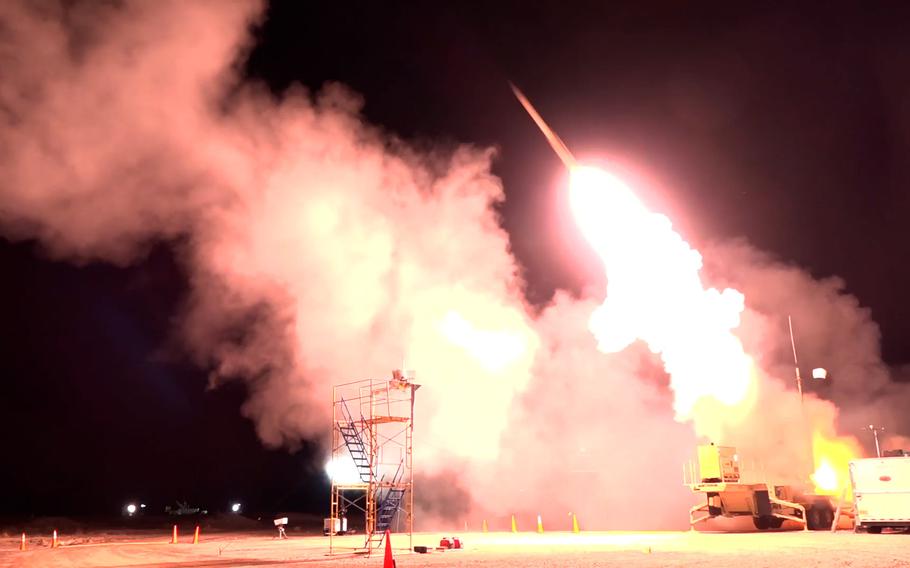
A Terminal High Altitude Area Defense launcher fires an interceptor missile during a flight test at an undisclosed location on March 29, 2022. The U.S. expended nearly 14% of its THAAD inventory during the June 2025 conflict with Iran, according to researchers at the Jewish Institute for National Security of America. (Missile Defense Agency)
It could take three to eight years for the U.S. to replenish its stockpile of high-altitude missile interceptors after the military launched nearly 14% of its arsenal during last month’s conflict with Iran, according to a new report.
The analysis, conducted by researchers at the Jewish Institute for National Security of America, found that interceptors fired by the United States’ Terminal High Altitude Area Defense systems accounted for nearly half of all interceptors used to protect Israel from Iran’s medium-range ballistic missiles during the 12-day bombardment.
While the THAADs — along with Israel’s Arrow-2 and Arrow-3 interceptors — successfully destroyed 201 of Iran’s 574 missiles, the rapid depletion raises concerns about capabilities in future conflicts, said Ari Cicurel, author of the report.
“It sent a clear signal to Iran, to Russia, to China, that we’re willing to use our military assets in defense of our closest partner in the Middle East and to help it defend itself and defeat attacks,” said Cicurel, who is JINSA’s associate director of foreign policy. “But it also means that we need to rapidly replenish our stockpiles, and not just go back to baseline levels.”
The Pentagon did not immediately respond Wednesday to questions about JINSA’s estimates or concerns about a potential interceptor shortfall.
President Donald Trump has repeatedly expressed a desire to avoid more long, drawn-out conflicts in the Middle East.
But decisions to target Iranian nuclear facilities last month and Houthi rebels in Yemen earlier this year have raised concerns among defense analysts about readiness in other parts of the world, particularly the Asia-Pacific region.
The U.S. fired 92 THAAD interceptors during the conflict, Cicurel’s research shows, cutting into its total estimated supply of about 632.
THAAD interceptors are produced by Lockheed Martin and cost about $12.7 million apiece, according to recent budget estimates from the Missile Defense Agency.
The U.S. acquired 11 interceptors in 2024 and is scheduled to receive 12 more by the end of the year. Between 25 and 37 additional interceptors are expected by the end of fiscal year 2026, but replenishing the stockpile could still take three to eight years, according to JINSA.
Other experts say the recent use of THAAD interceptors in Israel could prompt Congress to spend additional funds to supplement the shortfall.
The report also found that the U.S. used roughly 30 Patriot interceptors defending Iran’s attacks against Al Udeid Air Base in Qatar. While Patriot missiles are cheaper and faster to produce, they don’t offer the same theater-level defense that THAADs do, Cicurel said.

A Terminal High Altitude Area Defense system stands ready to launch missiles at an undisclosed location on Dec. 12, 2023. (Duy Nguyen/U.S. Army)
Adding to Pentagon concerns, Iran’s hit rate appeared to increase during periods when THAADs were the primary means of deterrence, the report said, suggesting potential system limitations during sustained attacks.
Video of the interceptions analyzed by JINSA suggests that during periods in which THAADs represented more than 60% of interceptors used, Iran increased its hit rate by 1% to 4%.
“As interception systems are pushed to their limits, even minor inefficiencies or delays can have significant consequences,” the report said.
Still, Cicurel noted that the defense was still highly successful. Of the roughly 258 attempts to intercept Iran’s missiles, only about 10% failed, with 57 striking populated areas. A majority of Iran’s 316 fired missiles were allowed to strike unpopulated areas, according to JINSA’s analysis.
The THAAD production rate means the U.S. may have to choose between shoring up its own arsenal and fulfilling foreign deliveries, Cicurel said. Those include a $15 billion deal with Saudi Arabia to send over seven THAAD batteries and 360 interceptors.
Qatar also recently signed a $42 billion defense deal with the U.S. that includes THAAD systems.
Lockheed Martin on Tuesday reported an 11% increase in sales during the second quarter in the division that produces THAAD and Patriot missiles, The Wall Street Journal reported this week. The defense contractor added that it expects backlogged weapons order to reach record territory this year, the Journal said.